

Building Service Agility: How to boost business productivity through improving services (2 September 2021) by Saman Lawe. KPIs Aren’t Just About Assessing Past Performance. Many companies track KPIs as a way of predicting performance.
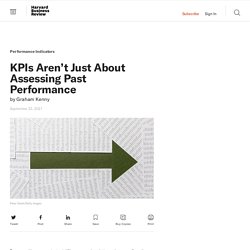
To really exploit the predictive power of KPIs, though, you need to map how the KPIs for your key stakeholders feed into each other and ultimately into financial performance. Executive teams are very familiar with using KPIs (key performance indicators) to track recent corporate success. These measures are used like school reports, providing feedback on how things went over the past year.
Employed this way, KPIs are backward looking and, as one executive described them to me, “just a bunch of numbers.” Igniting your next growth business. As accelerating trends widen the gaps between the best- and worst-performing industries and companies, your company’s future performance may well depend on your ability to position the corporate portfolio ahead of these trends.
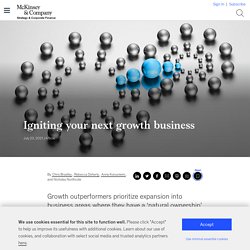
One way to do that is by expanding into new business areas. But how do you determine how far to venture from your core business, and in what direction? Misused business words: Accountability. Semantic satiation, a term coined by Leon Jakobovits in 1962, means that incessant repetition of a word leads to a loss of meaning for the listener.
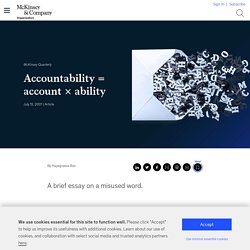
The language of management has several such words. One prime example is “accountability.” The term is so beloved by so many leaders at so many levels of so many organizations that over time it’s lost its truly powerful meaning. Etymologically, accountability derives from the Latin accomptare (to account), which stems from computare (to calculate), which, in turn, stems from putare (to reckon).
Use this agile technique little known in change management to get the best outcomes. The MoSCoW technique of prioritising initiative requirements or features The MoSCoW method of prioritization is well used by Business Analysts, Project Managers and Software Developers.
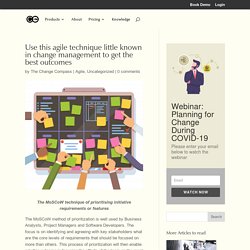
The focus is on identifying and agreeing with key stakeholders what are the core levels of requirements that should be focused on more than others. This process of prioritization will then enable a better outcome in focusing the efforts of the team on the most important aspects of the solution given limited time and cost. MoSCoW stands for: Must Have, Should Have, and Could Have. There is significant opportunity for change practitioners to also adopt this technique to better prioritise a range of different change interventions. Emerge stronger through disruption. Measure Performance: Strategies for Remote and Hybrid Teams. Story Highlights 44% of U.S. employees prefer working from homeThree domains can help measure hybrid and remote team productivityAlmost half of U.S. employees don't know what's expected of them at work While many leaders remain optimistic about the future of work in 2021, some unresolved questions have spilled over from 2020.
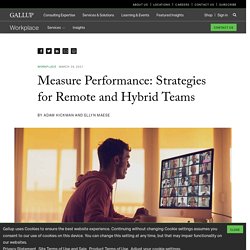
One being: How can organizations measure productivity with remote and hybrid teams? Some even wonder whether organizations should measure productivity after a year as difficult on employees as 2020. What's different now is not the performance measurement tools, but where employees are completing their work. How to Reconcile Resiliency and Efficiency in Your Company. The Six New Rules of Business: Creating Real Value in a Changing World (12 January 2021) by Judy Samuelson. Playful Solutions for Puzzling Problems. 18 October 2020 We are great with pat answers but awful with puzzling questions.

Faced with a daunting problem, we zero in on some established solution: wear masks in the pandemic, reduce carbon energy in a warming globe, fix capitalism to fix democracy. Sometimes these work, but too often insufficiently. Podcast: When Efficiency Goes Too Far. CURT NICKISCH: Welcome to the HBR IdeaCast from Harvard Business Review.

I’m Curt Nickisch. For many people around the globe, now is a time of reflection. The pandemic has made so many of us change the way we work, the way we interact, and the way we think and feel. It has also prompted many leaders to think more about how our economy is structured and what they can do to improve the system. L'efficacité par la généralisation de l'agilité organisationnelle (2017) par Séverine Meunier.
Building capability to unleash business performance. As business pressures only increase, organizations need to help develop workers’ human capabilities—curiosity, imagination, creativity, empathy, and courage—and encourage their application across all levels and departments.
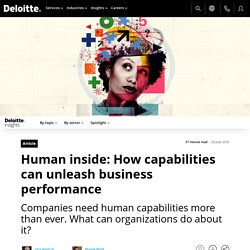
Introduction In the future of work, a paradox is becoming increasingly apparent and important: The more advanced and pervasive technology becomes, the more important humans are to the equation—humans as customers, humans as buyers, humans as engines of growth and innovation, humans as users, collaborators, and stakeholders. And leaders are seeing fresh importance in the ways in which organizations deploy and develop their people to create new value and navigate increasing ambiguity. And this only becomes more pronounced when large unexpected events further accelerate the pace of change. Why the role of the procurement function is key to survival. A host of factors, from digitalisation to globalisation, have underscored the importance of the role of the procurement function.

But damage wrought by COVID-19 serves as perhaps the most compelling evidence yet that chief procurement officers, or CPOs, must have a secure seat in the boardroom and unmitigated authority. As the virus spreads, upending industries and roiling markets, CPOs who on a basic level are responsible for sourcing critical goods and services, face the mammoth task of creating quick turnarounds and devising alternatives to avoid bottlenecks.
But their success in doing so depends on management support and the ability to act swiftly. Performing at the Speed of Change: Workflow Learning in a Pandemic. In this current pandemic we’re being forced to finally face how organizations learn.
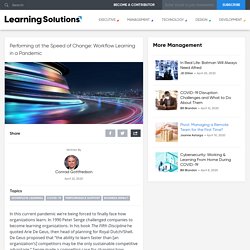
In 1990 Peter Senge challenged companies to become learning organizations. In his book The Fifth Discipline he quoted Arie De Geus, then head of planning for Royal Dutch/Shell. De Geus proposed that “the ability to learn faster than [an organization’s] competitors may be the only sustainable competitive advantage.” You Can't Incentivize Performance. Accelerated performance transformation for industrial, technology, and consumer companies. The term “disruption” constantly comes up when discussing technological advances over the past two decades. The explosion of social media and the internet, combined with the growth of the sharing economy, has transformed how we live and work. Now disruption is making headlines again. But this time, the term applies to new technologies that could have even greater impact.
Fighting the Gravity of Average Performance. New research shows that market leadership is increasingly temporary. The challenge for companies no longer lies in just getting to the front of the pack — it’s staying there. Strategy has always been about defying averages — doing something exceptional that earns a company correspondingly exceptional rewards in the market. Today, that is still true, but the relentless churn and volatility in the business environment mean that simply outperforming the average is not enough. Rather, the true test of leadership is continuing to outperform over time. We recently studied the performance trajectories of 22,000 companies over the last four decades. How to Thrive in the 2020s. How to Thrive in the 2020s - Winning the ’20s. Tom Peters on superior performance. Boston Consulting Group. Adopt a uniqueness mindset. Defying the average begins with a clear articulation of what is unique about a company and the value it can deliver. Look at your purpose, vision statement, and strategy with a skeptical eye and ask yourself whether a reasonable person could identify the specific industry, let alone the specific company, to which it pertains.
How prioritizing initiatives fuels performance turnarounds. August 26, 2019In cooking, whether you are a master chef or novice, the sequence is crucial. Performance improvement programs are much the same as recipes, but since companies must address a multitude of variables to boost productivity, success can be significantly more difficult to achieve. Consider one global luxury car manufacturer that was mired in a cycle of poor performance. Sales and production standards had declined, and the brand had lost its distinction in the market. A new ownership team acquired the carmaker and set an ambitious goal: become the world’s most progressive luxury car brand. The owners first conducted an Organizational Health Index survey to assess the carmaker’s starting point and challenges. Presence and Focus - Essential Skills for Collaboration. The five frames of performance and health. In Beyond Performance 2.0 (John Wiley & Sons, 2019), McKinsey senior partners Scott Keller and Bill Schaninger draw on their 40-plus years of combined experience, and on the most comprehensive research effort of its kind, to provide a practical and proven “how to” guide for leading successful large-scale change.
This article, drawn from the book’s opening chapter, provides an overview of this approach and explains why it works. Future articles will deal with specific topics such as uncovering and shifting limiting mind-sets during change efforts, as well as how to create the ownership and energy needed to succeed. The 8 Ways Companies Get Work Done, and How to Align Them.
Organizational effectiveness goes digital. Prosper In An Intelligent Economy With Intelligent Enterprise. Agile performance management. Leadership for a better performing organization. Performance Management: A Practical Introduction 2nd Edition (2018) by Linda Ashdown. Measuring and Managing Corporate Vitality. Operational Excellence: How to Make it Stick. Recovering labor productivity growth The opportunity in government productivity. Discretionary energy: a key measure of productivity - Korn Ferry Focus. Why productivity growth is slowing down in advanced economies and how to boost it. Moving from best to better and better. Business practice redesign is an untapped opportunity - Deloitte. Accelerating the shift to a next-generation operating model. A new opportunity for business process redesign.